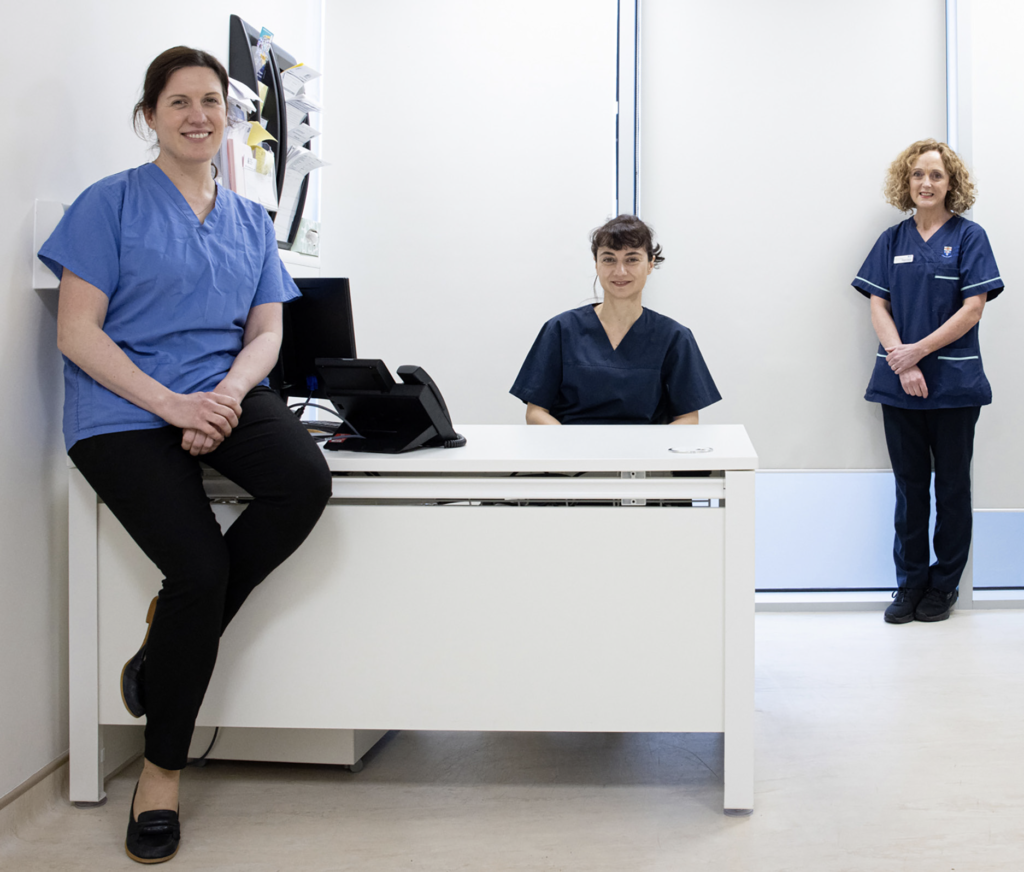Paul Mulholland reports on the establishment of a new clinical pathway developed for people with migraine and headache, which was piloted during the Covid-19 pandemic.
Anew headache clinical pathway, following a Sláintecare-funded pilot project, recently received approval from the HSE to be rolled out across the health service.

The project was piloted across three neurology centres in Galway University Hospitals, Tallaght University Hospital (TUH) and St James’s Hospital in Dublin during 2020 and 2021, with funding provided from the Department of Health’s Sláintecare Integration Fund.
Following the HSE’s approval of the pathway, planning has commenced in regard to funding and commencement of implementation in seven additional sites.
The service is led by the HSE National Clinical Lead Programme for Neurology in collaboration with the Migraine Association of Ireland (MAI), the Irish Pharmacy Union, and the academic unit of neurology at Trinity College Dublin.
Prof Orla Hardiman, HSE National Clinical Lead in Neurology, told the Medical Independent (MI) about the origins of the project. It developed following a request made by the clinical programme for neurological centres to conduct an audit to determine how many people on their waiting list were referred for headache- or migraine-related issues.
“We knew at the time there were between 21,000 and 24,000 on the neurology waiting list,” Prof Hardiman said.
“And the percentage of people on the waiting list with headache was between 25 and 30 per cent in every single centre we looked at.”
Headache was also the seventh most common reason for attendance at emergency departments and the second most common reason for attendance at medical assessment units.
Based on the findings, it was decided to make a submission to the Sláintecare Integration Fund to resource a pilot headache pathway across three sites.
“So we put in a proposal to Sláintecare to try and change the patient journey or the patient pathway so that we could address the roadblocks in the waiting list, and also improve the outcome for patients,” according to Prof Hardiman.
Pilot
The objective was to pilot a programme that linked services across the hospital, community, and voluntary sectors.
Prof Hardiman said the pathway was based primarily upon the model of care for headache, which was published by the clinical programme in 2016, “along with some insights we gained from visiting the sites.”
We put together a pathway that would start with the general practitioner, to allow the GP to identify the people who could be managed appropriately within the community
“These included the need for additional specialist nurses, and the need to recognise that headache and migraine is a long-term problem, which would benefit by teaching people how to self-manage.”
The teams which delivered the new service included neurologists, clinical nurse specialists (CNS), psychologists and targeted administrative support. The MAI partnered with the project to streamline services available to patients, especially psychology support groups in the community to facilitate self-care and long-term management of headache. In doing so, the need for ongoing engagement with hospital-based services was reduced.
Challenges
A partnership with pharmacies was also put in place. Prof Hardiman said this was because pharmacists are often the first point of contact for people suffering from headache and migraine, and provide advice to help with medication compliance.
“We engaged with the Irish Pharmacy Union and set up a system whereby we asked pharmacists to help counsel people once they had started medication,” she said.
“For them to look at things like side-effect profile, and compliance with medication. We also asked the pharmacist to document people coming in looking for headache medication.”
While 85 pharmacies agreed to be involved in the pilot to date, which exceeded the target of 20, and over 300 patients have been referred to community pharmacies from the three sites, Prof Hardiman said the Covid-19 pandemic hindered this aspect of the project.
“It didn’t really work very well because of Covid,” she explained. “But it is something we would like to investigate further.”
According to data gathered, 37 per cent of consultations were virtual between January and June 2021 due to Covid-19 restrictions. Prof Hardiman said further analysis was required on the role of virtual consultations in the pathway.
She also noted there was “a lot of bureaucracy” in developing and running the pilot. The Sláintecare Integration Fund is managed and administered by Pobal. The organisation works on behalf of the Government to support communities and local agencies toward achieving social inclusion and development. Its remit does not usually include administering projects across the acute healthcare setting.
“There have been learnings, which I think Sláintecare would admit to,” she said.
“There are probably better and more efficient ways of running these types of projects.”
Results
Overall, Prof Hardiman said the pilot project was very successful in meeting its targets. The project reduced the amount of repeat visits patients make to the hospitals. In Galway, for example, 171 patients have attended the GP-led headache/migraine clinic and only two return appointments have been arranged. Benefits were seen in the other pilot sites (see panel).
Headache clinics have now been established with rapid access in TUH and St James’s Hospital with approximately 42 rapid access slots per month. The CNSs are available to support emergency departments and GPs to provide advice and education. Nurse-led clinics have been developed in St James’s and TUH.
Prof Hardiman noted the centrality to the project of the ICGP’s guidance document, Migraine: Diagnosis and Management from a GP Perspective. The document was written by GP Dr Mary Kearney; Consultant Neurologist Dr Martin Ruttledge; and CNS Ms Esther Tomkins.
“It is a really nice piece of work and it really is very informative,” she said.
“We put together a pathway that would start with the general practitioner, to allow the GP to identify the people who could be managed appropriately within the community.”
Prof Hardiman said the need to improve community diagnostics was identified in the pilot.
“There are patients, for example, where there would be a very genuine concern that the headache has some kind of sinister cause,” she said.
“The trouble was that the access to diagnostics within the community was limited, unless you had health insurance. That has been resolved, so there is a resource now for diagnostics to be organised through community settings through general practitioners. They can now request neuro-imaging. That has been a good outcome.”
MAI
Prof Hardiman also pointed out the importance of linking with the MAI in developing the pathway.
“One of the learnings from project was the value of partnering with the voluntary associations,” she said.
The MAI and the psychology team have collaborated to run community group sessions and developed a series of video content and resources for those living with headache and migraine.
Speaking to MI, Ms Hazel Breen, Communications and Information Officer, MAI, said the Association was “delighted to see how successful the Sláintecare headache pathway pilot has been to date and are excited to see the roll-out of the full 10 locations nationwide”.
“As the Migraine Association… is Ireland’s only migraine patient charity, our key role in this new pathway to care will be to provide updates, support, education, information, and reassurance to the patient, helping to further reduce emergency department visits and strain on healthcare resources,” Ms Breen said.

“As migraine and headache complaints are among the top ten reasons for referrals to the emergency department, this pathway will allow patients to take a more direct route to care, which will be instrumental in terms of improving patient outcomes at a primary care level.
“In addition, we will continue to provide self-management tools and education to patients across Ireland to help them manage their conditions in conjunction with treatment.
To date, we have received great interest and positive feedback surrounding the recent press release by the HSE announcing the pilot’s success, which further proves the need for this vital pathway to care.”
In terms of psychological support, new services with referral criteria have been developed as part of the pathway. An eight-week group psychology intervention programme has also been established with three group interventions delivered to date.
One of the learnings from the project was the value of partnering with the voluntary associations
A patient pathway audit was completed between October 2020 and September 2021. In the audit, details on 2,517 patients were captured. The data collated will help inform decision-making with further development of the headache and migraine services in Ireland. All of these elements were featured in the business case submitted based on the results of the pilot.

Pictured from L-R at TUH: Dr Claire Hannon, GP with specialist interest in headache; Dr Petya Bogdanova- Mihaylova, Consultant Neurologist; and Ms Sharon Moran; Clinical Nurse Specialist.
“For those patients who might need some additional support or care, we put in a programme where we would put in a specialist nurse in each of the 10 hospitals in the country that have neurological services…,” Prof Hardiman said.
“And that programme has been accepted and is going to be rolled out towards the end of the year.”
In conclusion, Prof Hardiman emphasised how the project is consistent with the ethos of Sláintecare.
“The motivation of the project has been to provide the best and highest quality of care as close to the community as possible,” she said.
“And the project has demonstrated that we can do this. That we can try and maintain the management of what is essentially a lifelong condition within the community and not require the patient travel to specialist centres for regular follow-up.”
Tallaght University Hospital View from a pilot site
Dr Petya Bogdanova-Mihaylova is a Consultant Neurologist in Tallaght University Hospital (TUH), which was one of the three sites selected to pilot the new headache clinical pathway.
Speaking to the Medical Independent (MI), Dr Bogdanova-Mihaylova said the pilot has proved beneficial in terms of establishing a national commitment to improving and integrating different levels of headache care in Ireland.
“In TUH the pilot showed not only a reduced number of return headache visits to neurology outpatient clinics, but also positively affected the re-attendance rate of migraine patients to the emergency department (ED),” she told MI.
“Of patients who attended previously (with more than two prior ED attendances), none returned to ED since being linked in with the multidisciplinary headache services.”
Dr Bogdanova-Mihaylova said implementation of the pathway in TUH, with its emphasis on multifaceted education and training, led to improvements in the quality of patient care and ultimately to improved quality-of-life.
“The role of the headache clinical nurse specialist proved essential in terms of establishing good relationships with patients and their families, who have direct access to a specialist input as required, and thus promoting a model of self-care,” she said.
“Furthermore, patients with migraines and headaches value the opportunity to avail of psychological support and the feedback about the psychology service to date has been extremely positive, with a high level of interest and a good level of engagement with the service.”












Leave a Reply
You must be logged in to post a comment.